Suite of Life
Jul 29, 2022

Jul 29, 2022

This article originally appeared in the Spring/Summer 2022 issue of A.T. Journeys, the membership magazine of the ATC.
The Appalachian Trail (A.T.) is a through-line for hikers and the backbone to a vast, complex, and fragile ecosystem that needs continuous care to remain connected, intact, and healthy. The Science and Stewardship team at the Appalachian Trail Conservancy (ATC) works constantly to monitor and manage the health of these lands and forests by identifying threats and working to curb them. This work is crucial to maintain both the integrity of the A.T. landscape’s ecology and the Trail experience itself. One significant peril is the emerald ash borer, a beetle that is decimating many species of ash trees, which are integral to the green tunnel so many people know and love.
Photo above: A stately ash tree stands tall in a protected grove near Spivey Gap, North Carolina.
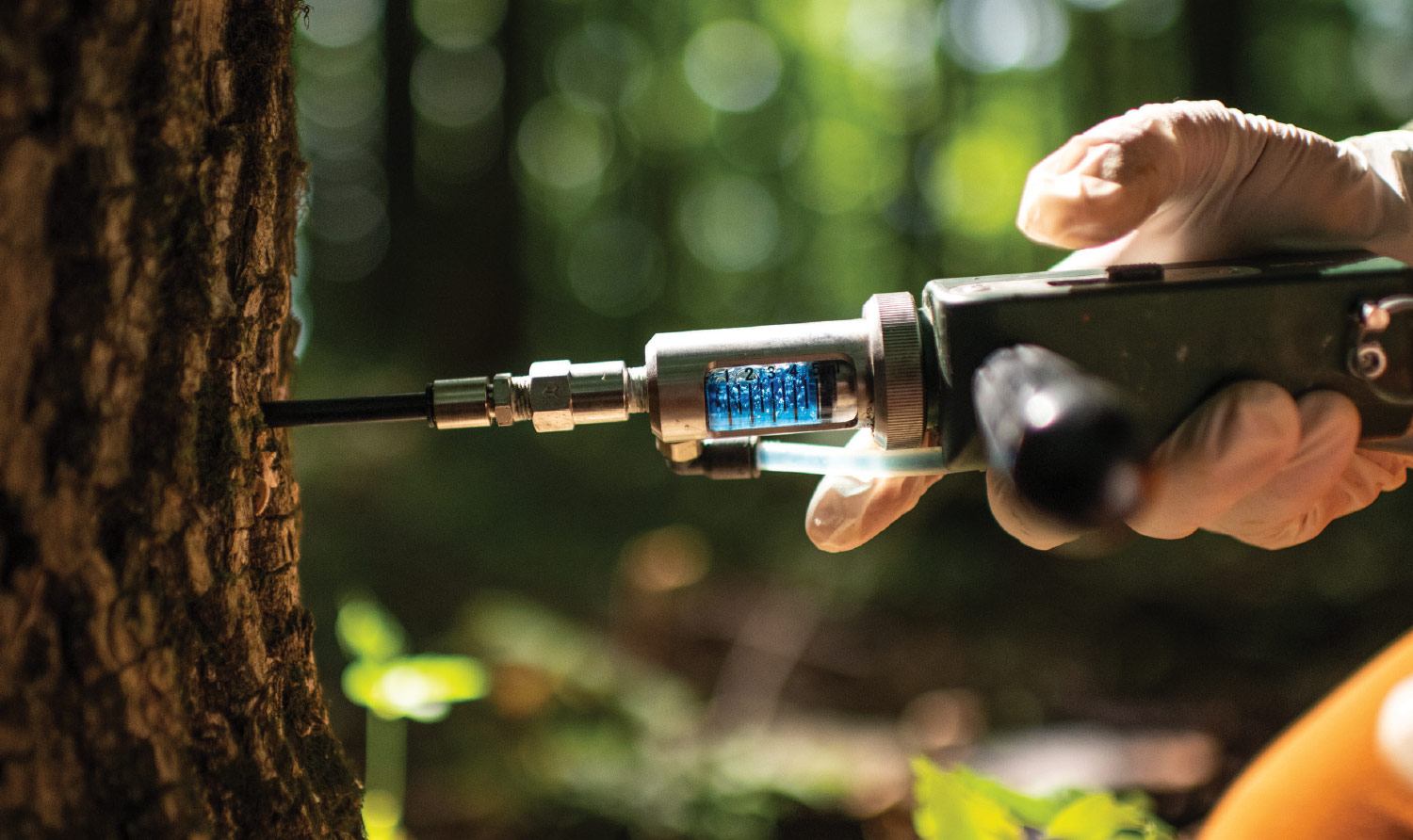
Injecting a systemic insecticide into a healthy tree in advance of attacks from devastating emerald ash borers. Photo by Chris Gallaway/Horizonline Pictures
Crouched among ferns by a sentinel white ash, Matt Drury from the ATC and Josh Kelly from MountainTrue are laser-focused on their task. MountainTrue is a nonprofit dedicated to the conservation of forests and waters in the southern Blue Ridge Mountains. Kelly serves as the group’s public lands biologist. Drury is ATC’s associate director of science and stewardship, out of Asheville, North Carolina. The two are professional partners who share a passion for their home forests.
Above Drury and Kelly, a canopy of buckeye, sugar maple, basswood, yellow birch, and ash pattern the sky. A fluting song of a wood thrush filters through the leaf-struck sunlight. The understory brims with shade-loving plants, from the medicinal blue cohosh to mayapples. Within this haven of a Tennessee cove forest just off the A.T., life is both lush and fragile. Today Drury and Kelly are injecting systemic insecticides into a healthy tree in advance of attacks from devastating emerald ash borers. Their life-saving efforts are part of the largest landscape-level project aimed at preventing ash tree extinction in the Appalachian Mountains. What makes the A.T. ash project particularly ambitious is the focus on backcountry trees — far more difficult than injecting chemicals in ash near homes, on city streets and in parks, where most treatments take place.
While every ash is important, the trees that dwell among a thriving forest community are entwined with a suite of life — from pygmy salamanders hunting insects up moss-cloaked tree trunks to black bear mothers raising cubs. This ecosystem reaches beyond the A.T. footpath and its corridor. Saving ash trees is an essential component to the carefully orchestrated work to preserve the delicate, natural landscape that spans the eastern U.S.
Since 2016, the ATC and its partners have treated nearly 1,200 white ash trees surrounding the A.T., with more than 900 in the Southeast and 240 in New England. The work is costly, labor-intensive, and requires going back to dose their patients every three years and likely over the next few decades. So far, almost all those trees remain alive.
The shady forest floor near the A.T. at Wayah Gap and Siler Bald in the Nantahala National Forest. Photo by Shira Zaid
“Ash tree protection is one piece of the larger puzzle,” says the ATC ’s Marian Orlousky, director of science and stewardship. “When paired with land protection and other resource restoration measures, we can address threats to biodiversity and encourage greater ecological resilience in the natural community. The scale and scope of resource protection is equally important, and the A.T. landscape is of the right scale for addressing forest-level threats.” She points to the importance of the Trail’s 2,194-mile-long corridor affording plant and animal populations opportunities to adapt and move north in latitude or up in elevation as habitats are altered by climate change. The more encompassing the corridor and the better connected it is to other natural landscapes, the better for genetic diversity and resilience as native species confront a barrage of threats, including invasive plants and pests introduced from other continents.
Ash tree protection is one piece of the larger puzzle. The scale and scope of resource protection is equally important, and the A.T. landscape is of the right scale for addressing forest-level threats.
Time is short when dealing with the deadly efficient emerald ash borer. A flashy metallic beetle a bit larger than a cooked grain of rice, the insect likely entered North America in the 1990s as an accidental stowaway within solid wood packing boxes shipped from East Asia. Adults hatched and got to work finding the genus Fraxinus (ash) as a host for laying eggs on the bark. Back in their native habitats, the borers are kept in check by predators, but not so here where trees did not evolve with this newcomer. It wasn’t until 2002 that foresters noticed ash trees dying near Detroit, Michigan, with what would become telltale signs — a death from the top down and tall trees breaking in the middle.
Now, hundreds of millions of ash trees across North America have succumbed to the beetles. Within two to three years after the larvae hatch and bore into the cambium below the bark, their feeding galleries cut off a tree’s transport system for water and nutrients. Every ash tree with a trunk bigger than your pinky finger is a potential target.
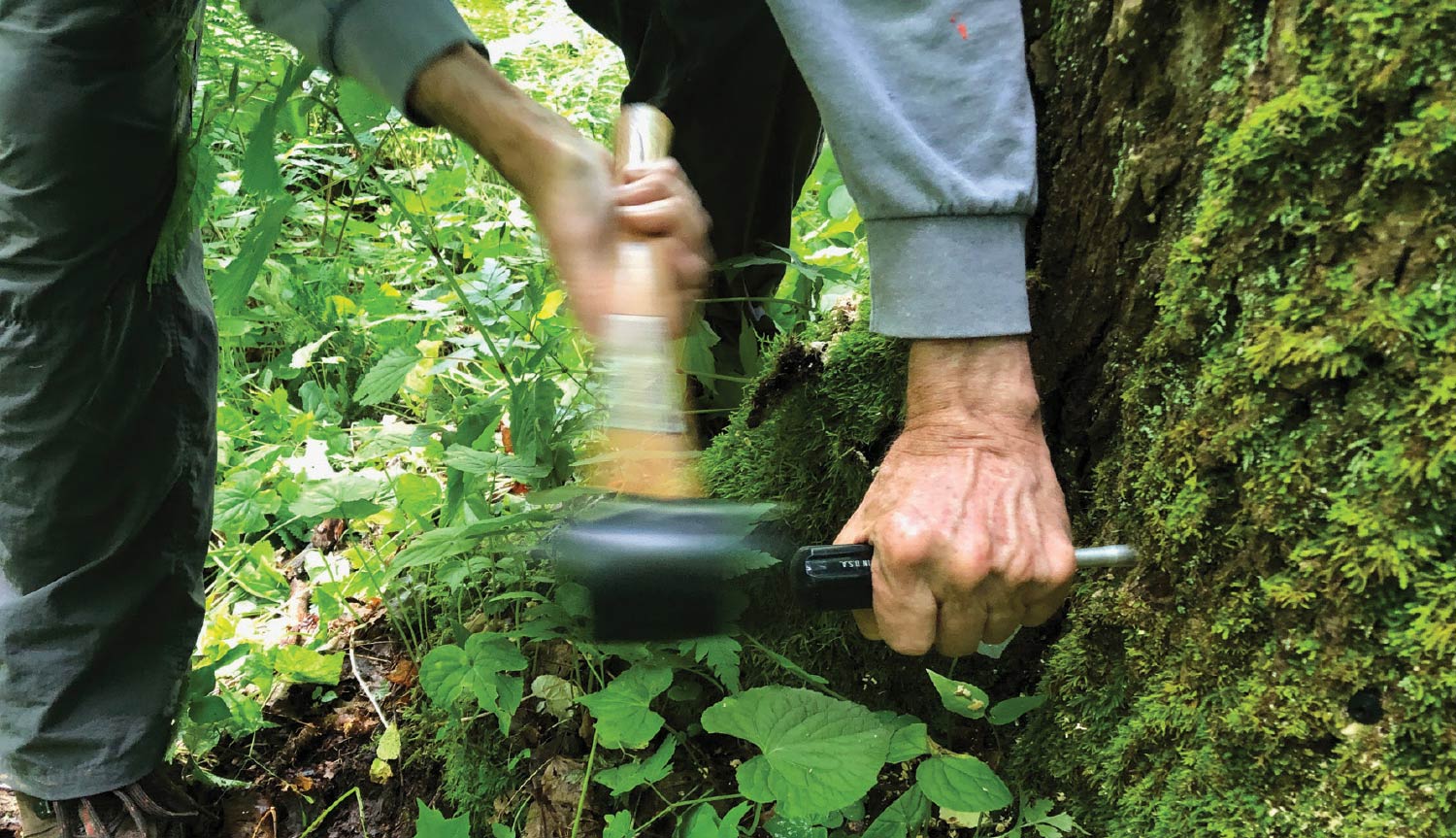
Mountaintrue ecologist Bob Gale hammers in an arbor plug in preparation for insecticide treatment. Photo by Matt Drury
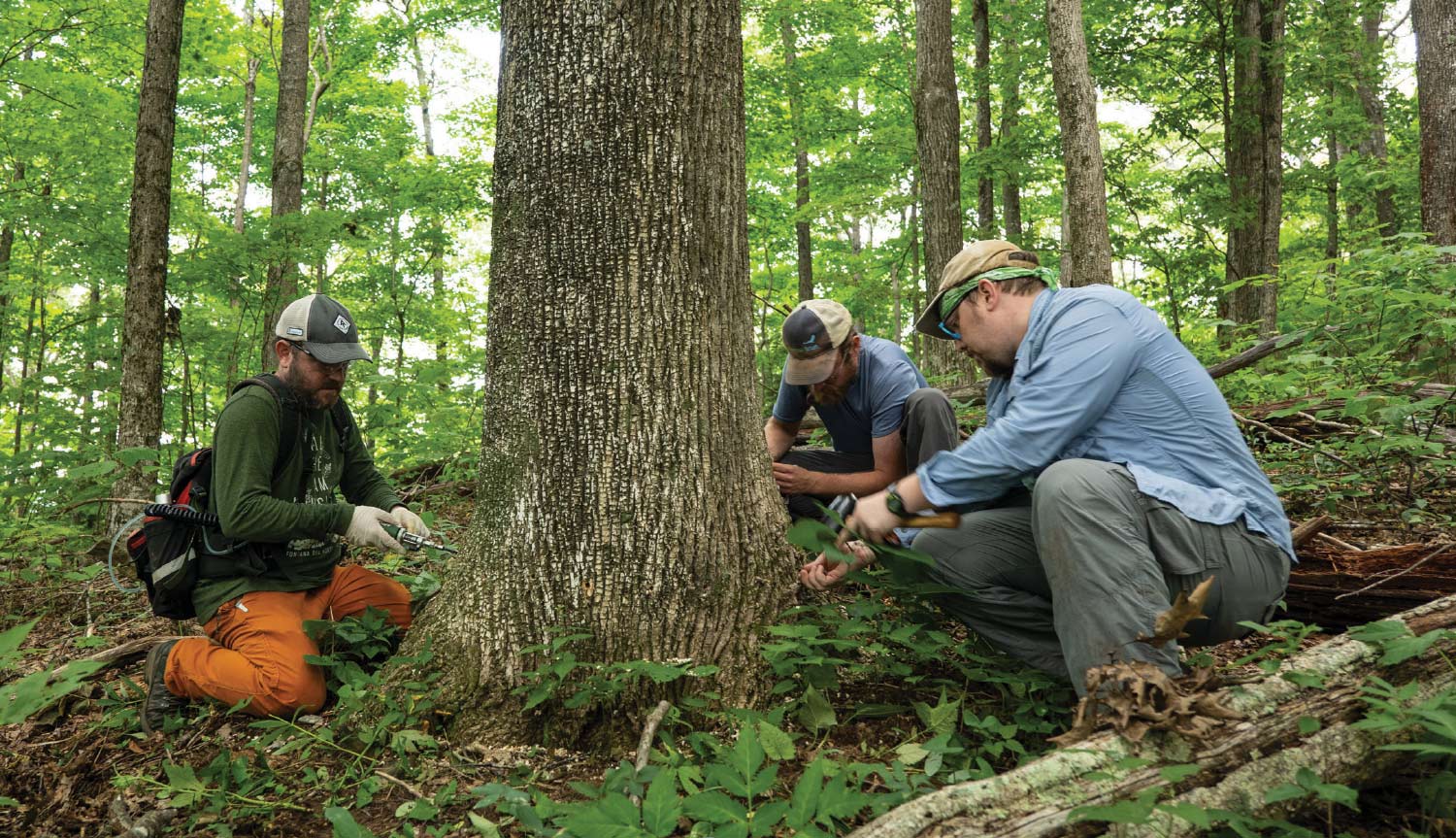
The ATC’s Matt Drury and partners from Mountaintrue (Josh Kelly) and hemlock restoration initiative (Thom Green) treat an ash tree at Spivey Gap. Photo by Chris Gallaway/Horizonline Pictures
Five of the sixteen species of ash in North America are at highest risk of going extinct and among them are the most dominant kinds — white, green, and black ash. The potential destruction could mount to the loss of eight billion trees and a cascade of unforeseen consequences within ecosystems. Ash trees range across sixty percent of the U.S. — mostly on the eastern half of the continent.
Along the A.T., primarily white ash and some green ash compose a vital three-to-five percent of shady forests. Hundreds of species of insects and spiders interact with ash and forty-four other species depend on them exclusively for survival. Wood frog tadpoles hatching in vernal pools grow larger, faster, and survive better when the leaves that fall into the water are from green ash. The trees host caterpillars so specialized to feed on them that some of the names contain the word “ash,” like the great ash sphinx moth. Songbirds like the scarlet tanager glean ash leaves for miniscule insects high up in the lofty tree canopy.

A dead ash tree near the A.T. in North Carolina; Josh Kelly of Mountaintrue measures an ash tree to calculate the proper dosage of insecticide. Photos by Chris Gallaway/Horizonline Pictures
I listened to the whistled chirruping of a scarlet tanager on a June solstice day in 2019 within that magical cove forest just off the Trail. I’d followed every detail as the team of Drury, Kelly, Bob Gale (ecologist and public lands director of MountainTrue), and intern Olivia Votava measured, recorded, prepared, and injected a dozen trees, all with diameters greater than twenty inches. As chemicals slowly entered drilled holes, I was reminded of chemotherapy that kills good and bad cells alike but can make the pivotal difference in survival. With limited supplies of the costly concoction, Drury and Kelly often face agonizing choices. Which tree to save? Which tree to leave? Drury prioritizes choosing ash along the A.T. that are within one-and-a-half times tree height of the Trail (white ash grow about fifty-to-eighty feet tall). He considers the structural integrity, lean of trees, and position within the forest canopy. His intent is to lessen the number of hazard trees hikers might encounter as the ash borer moves through, and to assure hikers can appreciate the beauty of the living trees.
Some treated trees with their diamond-shaped, corduroy gray bark even display the white A.T. blaze. I like to think hikers a century from now will place a hand on one of those blazes and celebrate the existence of a tree that came so close to extinction. Ash rely on wind pollination to send their clusters of oar-shaped samsara (wing) seeds into surrounding forests to plant hope for the future. Since the A.T. follows side slopes and ridges, the trees in these sections are well positioned for seeds to glide far into nearby forests.
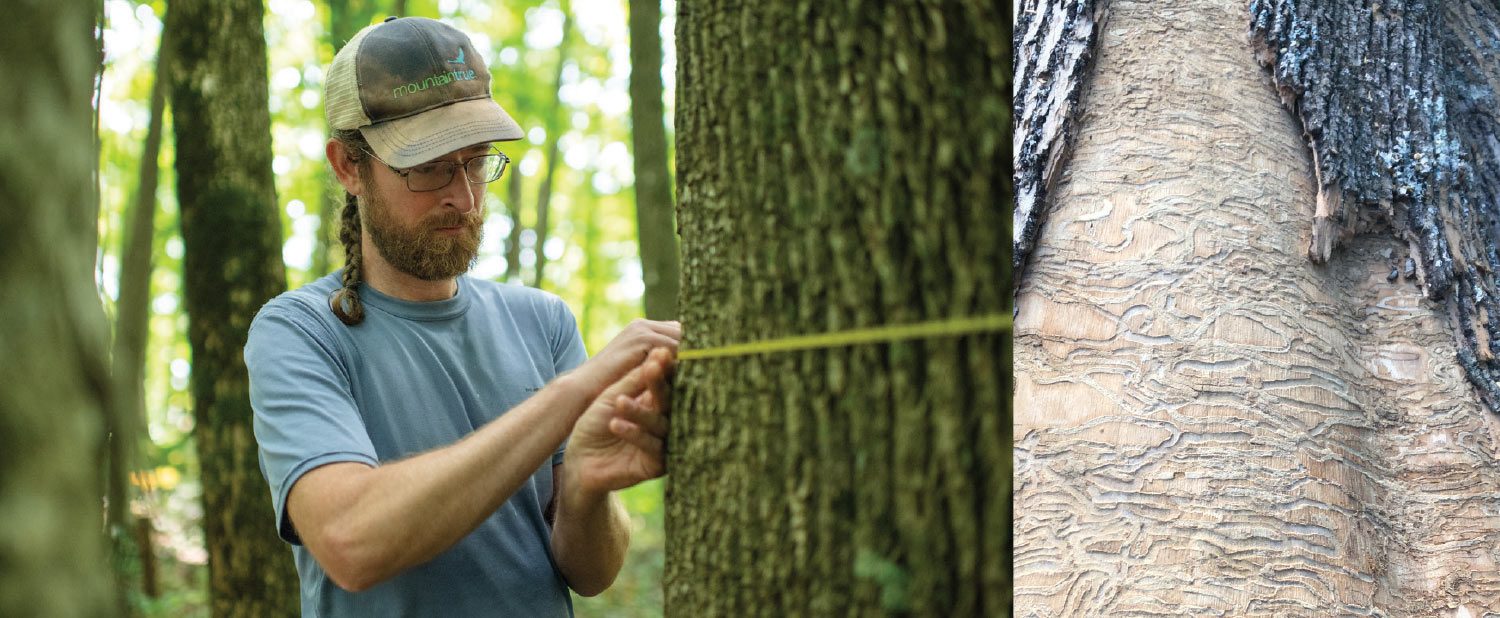
Emerald ash beetles bore into the cambium below the bark, cutting off a tree’s transport system for water and nutrients. Photo by Matt Drury
The borers move two ways. The number one culprit for spread is transporting firewood containing the larvae that hatch to fly with an uncanny ability to detect nearby ash and lay their eggs. Educating people not to transport firewood away from home is key to prevention efforts. Once established, individual beetles can fly a half mile or so from tree to tree. The borers can advance about ten to fifteen miles per year and don’t tend to double back. This trajectory helped Drury select twelve A.T. sites in North Carolina, Tennessee, and Georgia.
Kelly had returned to the same cove in 2021 to check on the trees within this 600-acre Moffett Laurel Botanical Area in the Cherokee National Forest. The borer had arrived, and the contrast could not have been starker. Already ninety percent of the unprotected ash had died, while at least ninety-five percent of those treated looked healthy. The trees are slated for their second injections this summer. “What we are doing is working,” Kelly says. “The ash trees that remain will provide the genetic pool for reestablishment.”
Among that lucky dozen safeguarded from the borer in the special cove is a thirty-nine-inch diameter wonder, the second largest ash of all treated so far under Drury and Kelly’s leadership. It took half of a $500 bottle to infuse this one tree. Impulsively, Drury gave the ash a name: the “Dave Richie tree” in honor of my dad who served as the A.T. project manager for the National Park Service in the 1970s and 80s, an era pivotal to securing a protected trail corridor from Georgia to Maine.
The more intact the forested wilds, the richer the refuge for people and for the native flora and fauna of the Appalachian mountains.
Another key quality that ups the odds for beating the borer is the people who are stepping up. The A.T. has long inspired volunteers to conserve, restore, and maintain the Trail and surrounding lands. One of those is Jim Pelletier of the Appalachian Mountain Club in Massachusetts, who for the past two decades has shared his field knowledge of the natural world coupled with trail-building and maintenance skills. Pelletier knows ash trees as companions to red and sugar maple, oaks, and black cherry. While the rapid loss is disheartening, he sees through the lens of the curious naturalist. Yes, he’s worried about the fate of delicate rare plants wedded to shade and how they will fare with sudden sunlight as the ash trees lose their wide umbrellas of leaves, break, and then fall. But he also revels in the many woodpeckers moving in to feast on the borers. “It seems to me there’s a lot out there we don’t know and our world is full of surprises . . . so it’s best we keep learning,” Pelletier says.
As the club’s natural resource coordinator, Pelletier helps to identify the best places to protect individual ash trees along the Trail in the Berkshires of western Massachusetts. He’s motivated to give back to the Trail that offers an accessible haven for people to reflect and find renewal in wild nature. “With all that’s going on in our world, our country, and our personal and work worlds, I think having this refuge is more important than ever,” he says.
The more intact the forested wilds, the richer the refuge for people and for the native flora and fauna of the Appalachian Mountains. The sites in Massachusetts selected for ash tree treatment are known for high biodiversity and presence of species of special concern. At one of the locations, the ATC has prioritized the removal of invasive barberry over 100 acres to stop the non-native shrub from outcompeting shade-loving plants. “We conducted restoration work at the site for six years until we missed one because of Covid-19, only to return and find the ash had begun to show signs of damage due to the ash borer,” Marian Orlousky says. They moved in quickly to treat the remaining healthy ash trees in 2021 and await the outcomes with cautious optimism. “Even if we eventually lose the ash from this site, slowing the loss over time will help maintain the canopy structure, reduce the influx of invasive species, and help protect the understory community,” she says.

Songbirds like the scarlet tanager find refuge and sustenance in the lofty tree canopy. Photo by Peter Brannon

A healthy forest supports native flora and fauna like red columbine and red eft salamanders. Photos by Raymond Salani III
No one involved knows what’s in store ultimately, but what they do know is how it feels to gaze up into a living ash tree as winds lift clusters of winged seeds and send them spinning into a waiting forest.
While the outlook for ash is still dire, there is encouraging news. In 2020, an international team of scientists identified the genes in ash trees that are key to fighting off the ash borer and will inform efforts to grow resistant trees. Researchers also work to locate ash trees with natural defenses that keep them alive longer than others. In 2021, they began planting trees in nurseries to compare those with genetics giving the trees some ability to kill off the attacking larvae and those with none. Their goal is to cultivate more trees with some resistance.
Back on the A.T., Paul Merten, an entomologist with the U.S. Forest Service out of Asheville, North Carolina, joins Josh Kelly and Matt Drury. Merten started releasing parasitoid wasps in 2016 on sections of the A.T. closest to Asheville. The tiny stingless wasps from Asia are specialists that prey on the larvae or eggs of ash borers. “Trying a biocontrol is the Hail Mary pass in the fourth quarter. It’s do or die,” says Marten.
Some sites on the A.T. with at least twenty-five percent forest coverage of ash and contiguous forests met Merten’s protocol for releasing the wasps. The first site he found when hiking uphill on the A.T. was staggering in its richness of ash — forty percent of the forest. When Merten trapped an ash borer, he was ready to bring in the wasps that shipped live to his office from labs run by the APHIS (Animal and Plant Health Inspection Service) of the U.S. Department of Agriculture. His first box contained 1,200 of the wasps and three different species. He continued to set more of the borer predators free as the wasps arrived in weekly batches that summer of 2016. “The web of biology is convoluted,” he says. “When you insert a new organism into an ecosystem there is a lot of shock and things we cannot measure or perceive.”
Merten released wasps every two years at four sites from 2016 to 2019, making sure those areas do not overlap with those containing treated ash. Now, he monitors for their presence — setting up traps that look like yellow party bowls for ice cream. There are introduced parasitoid wasps showing up in the traps, and that’s good news. Biocontrol takes time and patience for results.

The iconic A.T. white blaze on a tree in the Nantahala National Forest, North Carolina. Photo by Shira Zaid
From a golden eagle’s view tracing the Appalachians from Georgia to Maine, the ash tree treatments of the Southeast and in Massachusetts might seem too few and far between. However, the sites are positioned on the continuum of the Appalachian Mountains and that’s significant, despite the gaps. The borer is now found along the Trail in all states. Close to the ATC’s headquarters in Harpers Ferry National Park, there were 18,500 live ash trees in 2013 and only 7,700 in 2021. Those tragic losses do not diminish the remarkable achievements in Georgia, South Carolina, Tennessee, and Massachusetts, and their promise for staving off regional extinctions.
Drury is thrilled every time he comes back on a three-year rotation. He’s coming to know individual trees like old friends. “South of Max Patch, we treated 250 trees and all but two survived,” he says. “I’m driven to roll the dice on the unknown and be optimistic about the outcome.”
No one involved knows what’s in store ultimately, but what they do know is how it feels to gaze up into a living ash tree as winds lift clusters of winged seeds and send them spinning into a waiting forest. Thanks to every champion of the A.T. from inception to now, we can celebrate the possibility for large-scale conservation and renewal of forests and the human spirit.
A.T. hikers know what it is to persist in wind, mosquitos, mud, snow, endless uphills, and punishing heat, only to revel all the more in every beauty spot along the way. So it is with the ash tree protectors who marvel at each tree saved like another summit reached. The view could not be finer.https://www.youtube.com/watch?v=fOln6DPMWqIMarina Richie is the author of Halcyon Journey: In Search of the Belted Kingfisher (Oregon State University Press, 2022), the first book to feature a beloved bird of North America’s waterways, including streams, rivers, ponds, and lakes along the Appalachian Trail. marinarichie.com
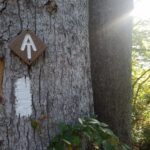

All gifts matched by a group of generous Trail Crew Alumni. Make your DOUBLED gift now!
Donate TodayGet the latest A.T. news, events, merchandise, and sneak peeks delivered directly to your inbox.